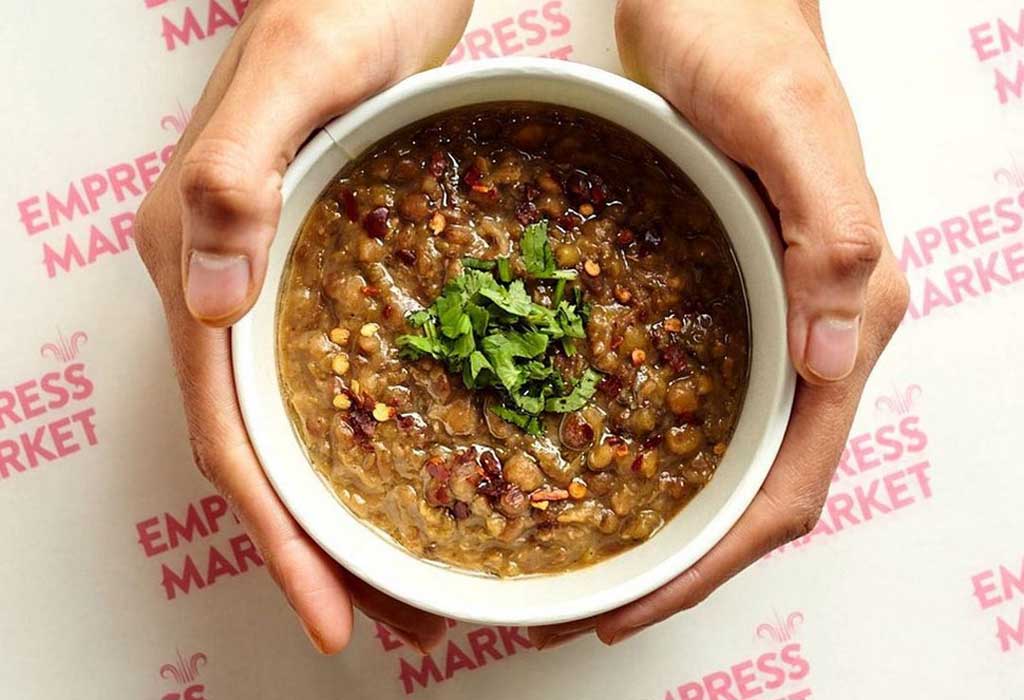Haleem by Salma Siddiqui – Parcha newsletter
Haleem is my favourite dish in the world. A classic South Asian meat and grain stew, it is best eaten on a November winter day.
The nights draw in and there is a nip of frost in the air. Time slows down, and every meal serves to nourish and soothe us. Coming home to a warm bowl of Haleem is the reward you deserve after a long day
My mum’s recipe. This is a dish to cook when you need to clear your mind and focus on one thing – how to savour the simple things in life.
Editor – For exclusive content of original recipes developed by Numra Siddiqui and her foodie friends, subscribe to Parcha – a newsletter about South Asian food and culture.
INGREDIENTS
Korma
- 1.5 kg mutton (leg and shoulder, on the bone)
- 500g sliced white onion
- 1.5 tsp red chilli powder
- 2 tsp salt
- 3 tbs garlic paste
- ½ tsp turmeric
- ½ tsp garam masala
- 250g fresh yoghurt
- 4 tbs vegetable oil
Garnish
- 1 bunch of fresh coriander, roughly chopped
- 4 inches of fresh ginger, julienne/sliced into matchsticks
- 3-4 green chilli, thinly sliced
- 1 small red onion, thinly sliced and fried till brown
- 1 lemon, cut into wedges
Grains
- 120g wheat berries
- 120g pearl barley
- 120g white rice
- 120g chanaa daal (split chickpea)
- 60g Masoor daal (husked pink lentils)
- 60g Urud/Maash daal
- 60g Moong daal (husked mung bean)
- 2tsp red chilli powder
- 2 tsp salt
- ½ tsp turmeric
- 2 tbs garlic paste
- 2 tbs ginger paste
METHOD
Soak all the grain separately at least an hour before cooking.
The Korma
- Heat the oil, and add the onions, sweating them over a medium heat till they are soft and beginning to catch colour.
- Add the garlic paste and give it bhunnai till you can’t smell the raw garlic.
- With a splash of water, add the dry spices and continue giving bhunnai, until the woody turmeric scent has lifted.
- The mutton goes in next; coat it with the masala and brown off the meat.
- Add enough water, enough to cover the top of the meat chunks. Bring the gravy to a boil and then lower the temper to a gentle simmer.
- You can add more water if needed; you want the gravy to have a sauce like consistency, that can coat the back of a spoon.
- Continue cooking the korma until the onions have disintegrated and the meat is tender enough to fall off the bone.
- Remove the bones and keep them to one side if you intend to return them to the final Haleem.
The Grains
- Combine all the soaked grains in a larger cauldron with a wide base.
- Add the dry spices, garlic and ginger paste, along with enough water to cover the grains by an inch over the surface (this is roughly under double the amount of water to grain).
- Bring the water to a boil and then simmer on a gentle heat.
- Give the grains a stir to mix the spices through evenly, careful not to let the grains to catch at the bottom.
- Cook the grains until the water is absorbed and the wheat berries and pearl barley are cooked through. You will know they are cooked when they lose their solid hard bite.
- Take the cauldron off the heat.
- With the largest wooden spoon you can lay your hands on, crush the grains against the sides of the cauldron with the back of the spoon. You can use an immersion blender (allow it fam) to assist in pulverising the grains.
All Together Now
- Combine the korma to the daal and return the cauldron back to a gentle heat.
- Continue to pulverise the tender meat with the back of the spoon. All the pieces of meat should be broken to the fibrous, silken strands and the daals have all but disintegrated.
- You can return the bones to the stew if you like.
- Dress the Haleem with the selection of garnishes of your choice. Sorry mum, I like chilli oil (off menu).
Serving Suggestions
Haleem is satiates as a meal on its own in Utter Pradesh. In Punjab, fluffy naan is best used to lap up the stew, fare la scarpetta.
My family recipe for Haleem is enough to feed an army. Keeping with tradition, invite friends and family to eat Haleem with you, distribute containers of the stew to loved ones and neighbours, and stow way boxes in the freezer to last up to six months, to eat on a cold rainy day.
 My name is Numra, head chef and owner of Empress Market, and I share stories about South Asian culture through food.
My name is Numra, head chef and owner of Empress Market, and I share stories about South Asian culture through food.
At Empress Market I host experimental supperclubs, cooking demonstrations restaurant and street food pop-ups.
I publish Parcha, a digital newsletter sharing food stories and recipes about South Asian culture. You can read latest issues and subscribe by clicking on the poster above!
I am also the host of If These Meals Could Talk on Tastemade, where I welcome chefs and food writers into my kitchen to cook three recipes that shaped who they are today. The six part series is available on Sky, Apple TV, Samsung and the Tastemade website.
Follow her on: Instagram | Empress Market
If you have any recipes you want published, Contact Us now. We’d love to hear from you!



